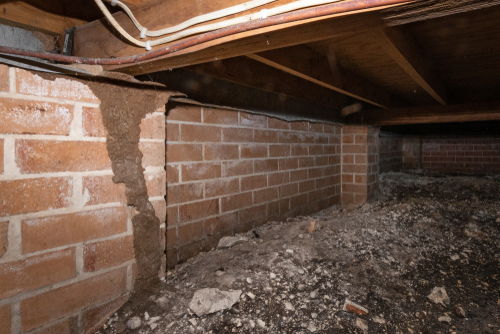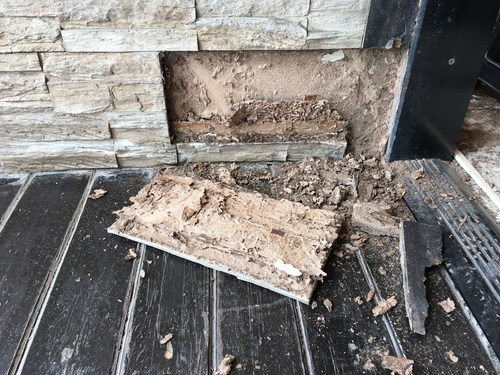Today Rapid Solutions is sharing not one case study of insurance claims against termite inspectors, but four. If you’re in the business of termite inspection, your customers count on you to provide a thorough and professional service. However, they might not always listen to your advice. Or you could miss some crucial piece of termite activity. When this happens your business could have a liability case on its hands.
In this article we suggest you take certain steps when inspecting for pests, referencing real life examples that might help reduce the risk of typical claims like these. If you’re in termite inspection, following this advice could save you from customer claims, financial losses and potential loss of business.
Read on to find out how.
Insurance claims against termite inspectors can cost big $$$
In each true life case study of insurance claims below, the customer claimed the termite inspector or company is liable for damage to property. Claims against the termite inspectors for damage and repairs range from $10,000 to $800,000 and more (complete demolition and reconstruction of properties).
Can you imagine if this claim was made against your business – would you be able to pay this sum? Ideally you can protect yourself by having professional indemnity insurance and general liability insurance and by following our suggestions below.

“Educate your customers. You’re never offering a guarantee to ‘rid‘ their homes of termites or to protect them from ever having a termite problem. Help them understand the risk of termites in Australia and that damage and activity is more likely than not. Also be clear that a visual inspection is limited.”
– Rapid Solutions CEO, Belinda Smith
#1. Case study where insured lost at tribunal
Let’s get the bad news out of the way before moving on to the better and good news. In our first insurance claims case study, the termite inspector was ordered to pay damages after homeowners lodged a complaint with the Civil and Administrative Tribunal for property damage.
What happened?
In this insurance claim case study, the termite inspector completed a pre-purchase inspection on a home. In their report, they identified the property was at high risk of termites and termite damage and recommended an invasive inspection due to conducive site conditions. The customer bought the property but, five months down the line, home renovations uncovered termite activity in the lounge area, concealed behind a fireplace.
They lodged a complaint against the termite inspector for property damage. We confidently stood by the inspector and denied their liability. After all, they had conducted a thorough inspection and made appropriate recommendations.. The homeowners also didn’t produce any evidence that the inspector had failed to spot any termite activity during their inspection.
Who is at fault?
The homeowners took the case to the Civil and Administrative Tribunal, which found in favour of the homeowners. Even though the inspector had made what appeared to be a comprehensive report, there was no evidence to support that some shelving in the garage on the other side of that fireplace was concealing termite entry. Had he taken photos of that area, and included them in his report, the tribunal may have found otherwise. The termite inspector was forced to pay nearly $10,000 in damages.

“Start every job with fresh eyes, as conditions have likely changed since you were last there. Customers won’t always follow recommendations or read all your reports. Go into every property expecting to find activity and damage.”
– Rapid Solutions CEO, Belinda Smith
#2. Case study of insurance claim where termite inspector may be at fault
In our second insurance claims case study, the termite inspector may have been responsible for the termite damage but the customer may have contributed to the circumstances that led to property damage from termites. There was no clear, obvious answer as to whether the inspector had been negligent.
What happened?
The termite inspector completed visual inspections on the property over a five-year period. They advised the customer to get inspections every six months and to get a builder to assess the extent of the termite damage that was visible at inspection. Two possible mistakes happened. Firstly, the termite inspector missed minor termite activity and damage under a water tank lid that caused floor damage. Secondly, the customer didn’t follow the inspector’s advice to call on a builder and find out the full extent of existing termite damage.
Who is at fault?
Both parties may be liable, but if found to be responsible the termite inspector could be forced to pay the full cost of flooring repairs – which was almost $10,000. Besides this, the termite inspector also wanted to keep the customer as a client in the future. In this insurance claims case study the termite inspector made an offer to settle and pay some of the costs of the damage. Thankfully they were able to make a smaller payment ($3,000) than the cost of the actual damage and settle with their customer.

“Be clear and specific with your recommendations– invasives, removal of conducive conditions, next inspection time and urgency of actions to be taken. Be clear on obstructions and limitations. Use photographs that are labelled to capture the current condition of the property. Clearly point out limitations and areas of activity and damage.”
– Rapid Solutions CEO, Belinda Smith
#3. A win on denial of liability
In the third case study of insurance claims, a customer claimed the termite inspector hadn’t followed the Australian Standards, resulting in termite damage.
What happened?
After completing the standard first inspection the termite inspector recommended that the homeowner have a follow up 12 months later. The homeowner didn’t follow this recommendation, waiting 18 months before scheduling the next inspection. Unfortunately it was too late and the inspection revealed termites had gained entry to the property. The termite inspector completed treatment and recommended a barrier installation. This time the customer followed the advice and had the inspector conduct regular inspections over the next two years.
Unfortunately more termite activity was discovered during home renovations. The termite inspector recommended an invasive treatment to properly assess the extent of activity, potential entry points and damage to timbers. The inspector also advised that the termites had likely been attracted to the home environment because of water leaks – a highly conducive condition.
Sadly for the homeowner, they made two mistakes. Not only did they overlook getting the source of the water leak investigated urgently but they also didn’t approve the invasive termite inspection. Instead, they brought an allegation against the termite inspector saying it was their fault for not doing the invasive treatment as “duty of care” with or without their go-ahead.
Who is at fault?
Even though the customer brought in an independent expert to support their claim, our position was firm. The termite inspector had solid paperwork with specific report recommendations, all documented. This paper trail, which captured the inspections, treatments, recommendations and current condition of the property was sufficient for a confident denial of liability.

“Review your paperwork before it goes to your customer. Consider how it might be viewed by an independent expert if they were assessing it for a claim. Keep your industry knowledge current and be sure your treatment proposals provide options with pros and cons where possible.”
– Rapid Solutions CEO, Belinda Smith
#4. Winning case study of insurance claims
The final case study of insurance is hair-raising. A claim for $800,000 in termite damage was lodged against the termite inspector in the Victorian consumer appeals tribunal. Thankfully they were insured with Rapid Solutions and we, like all the cases above, managed the claim.
What happened?
This case study involves a termite inspector who really takes great reporting seriously. In fact, their thorough approach to the inspection and reporting helped them to win their case. This time around the termite property inspection was done with the prospective purchaser present. The termite inspector took more than 200 photos to keep track of all the inspected areas and how they looked at the time of the inspection.
The report noted a high risk of termites, many obstructions and several conducive conditions. In it, recommendations were made for follow up inspections, invasive inspections, treatment and another follow up inspection no more than six months later. Almost a year later, the now homeowner served the termite inspector with a claim for $800,000. The allegation was the inspector had missed termite damage at the time of inspection and they would never have purchased the home if it was reported on.
Rapid Solutions’ building and termite experts went to investigate. They had a difficult task because it was more than two years since the original inspection, and the house was already undergoing extensive renovations and repairs. Thanks to the detailed reporting and photos the termite inspector took during their inspection, the experts’ job to determine the likelihood of missed termite damage was made much easier. Otherwise, it would have been a near impossible task to refute the allegations of the homeowner.. Rapid Solutions stood firmly by our insured termite inspector.
They had done a great inspection with a comprehensive report complete with documented warnings of termite risk, they had not missed any evidence of termite activity and damage and they weren’t liable for the allegations made against them.
Who is at fault?
As we prepared to go to a tribunal hearing for the case, we made an “Each bear own” offer. In legal terms this means each party will bear its own costs. It means neither one has a claim against the other. The “win” cost nearly $100,000 in legal and expert fees. However, this was nevertheless a great deal better than the original demand of $800,000. The homeowners agreed to our insured’s ‘walkaway win’ on the strength of the evidence we were able to present that there was no wrongdoing by the termite inspector.

Key lessons in reducing risk for your pest control business
As you can see from each termite management insurance claim above, conducting termite inspections and treatments is risky business. There are two major takeaways from this case study of insurance claims to help you reduce your risk of claims and manage them effectively when they do arise:
- Comprehensive reporting is crucial. Your report can literally save your business during a customer claim. You need to ensure every recommendation and concern is clearly communicated in writing and that you take photographs to keep a record of what was and wasn’t present during your inspection. Properties change because of weather, time and renovations but your photographs are proof of what state they’re in when you inspect. Photos carry so much information that simply can’t be shared the same way in writing. Read our guide to Rapid Reporting for more tips.
- Document all communication. Over and above great reporting, make sure all your suggestions and communication with your customer are also in writing. If you make any comment or suggestion – or they do – also follow up with an email recapping the same info. Read more on effective record keeping.
Safeguard your pest control business with insurance
Equally important to protecting your livelihood is having Rapid Solutions’ professional indemnity and general liability insurance. With it, your business has access to financial protection when you need to make an insurance claim. Whether it’s because of legal claims made against your business for breach of duty, property damage, lost documents and much more, your insurance policy is your safety net.
You’ll also have access to support from our experts who are leaders in pest control and our claims team are skilled and ready to support you in times of customer complaints.
And remember, if you let your insurance lapse, you’re no longer insured for claims for work completed previously. It’s why you should consider run off insurance if you decide to close your business.
Get the protection your pest control business deserves today. Contact us today to begin your quote.
